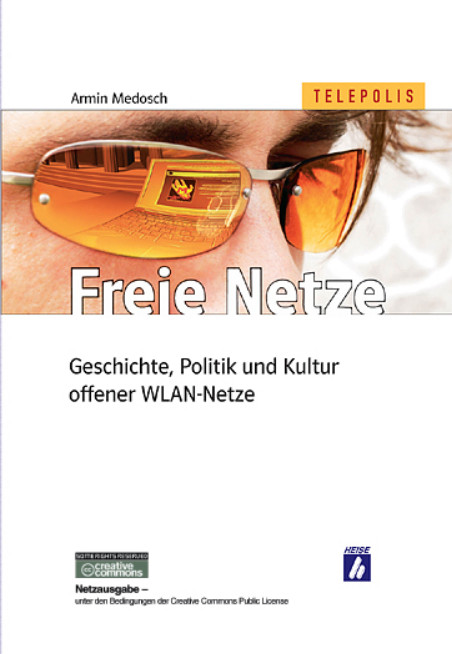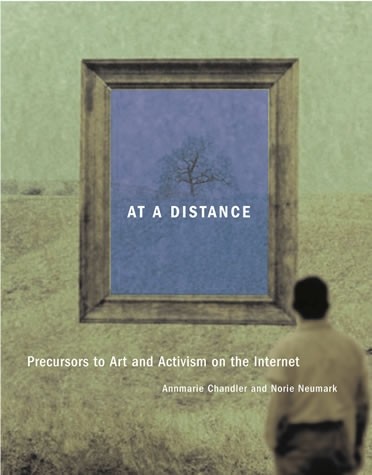Armin Medosch: Freie Netze. Geschichte, Politik und Kultur offener WLAN-Netze (2004) [German]
Filed under book | Tags: · internet, media, network culture, networks, open spectrum, politics, wireless networks

“In den letzten zwei, drei Jahren entstand eine Bewegung, welche die klassische Idee der Freenets, der freien Bürgernetze, mit der Technologie für Wireless Local Area Networks (WLAN) zu verwirklichen versucht. Diese freien drahtlosen Bürgernetze, engl. Wireless Community Networks bzw. Free Networks, die gleichzeitig spontan in New York, London, Seattle, Berlin, Hannover und weiteren Städten entstanden sind, bieten sich als alternative Modelle für eine nachhaltige Informationsökonomie an. Interessante Themen – Stichworte mobiler Lebensstil, War-Driving, Netz-Kartographie, Selbstorganisation und Dezentralität – werden aus einer Insiderperspektive spannend und lebensnah vermittelt.”
Publisher Heinz Heise, Hannover, 2004
Creative Commons BY-NC-ND 2.0 DE License
ISBN 3936931100
240 pages
PDF, PDF (updated on 2015-7-23)
Comment (1)Annmarie Chandler, Norie Neumark (eds.): At a Distance: Precursors to Art and Activism on the Internet (2005)
Filed under book | Tags: · 1970s, 1980s, activism, art history, experimental art, fluxus, mail art, media art, network art, network culture, networks, new media, radio art, telematics

“Networked collaborations of artists did not begin on the Internet. In this multidisciplinary look at the practice of art that takes place across a distance—geographical, temporal, or emotional—theorists and practitioners examine the ways that art, activism, and media fundamentally reconfigured each other in experimental networked projects of the 1970s and 1980s. By providing a context for this work—showing that it was shaped by varying mixes of social relations, cultural strategies, and political and aesthetic concerns—At a Distance effectively refutes the widely accepted idea that networked art is technologically determined. Doing so, it provides the historical grounding needed for a more complete understanding of today’s practices of Internet art and activism and suggests the possibilities inherent in networked practice.
At a Distance traces the history and theory of such experimental art projects as Mail Art, sound and radio art, telematic art, assemblings, and Fluxus. Although the projects differed, a conceptual questioning of the “art object,” combined with a political undermining of dominant art institutional practices, animated most distance art. After a section that sets this work in historical and critical perspective, the book presents artists and others involved in this art ‘re-viewing’ their work—including experiments in ‘mini-FM’, telerobotics, networked psychoanalysis, and interactive book construction. Finally, the book recasts the history of networks from the perspectives of politics, aesthetics, economics, and cross-cultural analysis.”
Publisher MIT Press, 2005
ISBN 0262033283, 9780262033282
xiv+486 pages
Reviews: Publishers Weekly (2005), Vincent Bonin (2005), Graham Meikle (Scan, 2006), Paolo Gerbaudo (Culture Machine, 2006), Joel Slayton (Art Book, 2006), Karrie Karahalios (New Media & Society, 2006), Jennifer Way (RCCS, 2008, with responses from editors).
PDF (updated on 2019-11-22)
Comments (3)Roy Ascott: Telematic Embrace: Visionary Theories of Art, Technology, and Consciousness (2003)
Filed under book | Tags: · art, conceptual art, consciousness, cyberspace, electronic art, networks, technology, telematics, telepresence

Long before e-mail and the Internet permeated society, Roy Ascott, a pioneering British artist and theorist, coined the term “telematic art” to describe the use of online computer networks as an artistic medium. In Telematic Embrace Edward A. Shanken gathers, for the first time, an impressive compilation of more than three decades of Ascott’s philosophies on aesthetics, interactivity, and the sense of self and community in the telematic world of cyberspace. This book explores Ascott’s ideas on how networked communication has shaped behavior and consciousness within and beyond the realm of what is conventionally defined as art.
Telematics, a powerful marriage of computers and telecommunication, made technologies we now take for granted—such as e-mail and automated teller machines (ATMs)—part of our daily life, and made art a more interactive form of expression. Telematic art challenges traditional relationships between artist, artwork, and audience by allowing nonlocal audiences to influence the emergent qualities of the artwork, which consists of the ebb and flow of electronic information. These essays constitute a unique archaeology of ideas, tracing Ascott’s meditations on the formation of consciousness through the intertwined cultural histories of art and technology from the 1960s to the present.
Shanken’s introduction situates Ascott’s work within a history of ideas in art, technology, and philosophy. Given the increasing role of the Internet and the World Wide Web in the creation of commerce and community at the dawn of this new millennium, scholars, students, laypeople, policymakers, and artists will find this collection informative and thought-provoking.
Edited and with an essay by Edward A. Shanken
Published by University of California Press, 2003
ISBN 0585465916, 9780585465913
427 pages
PDF (updated on 2012-7-24)
Comment (0)
